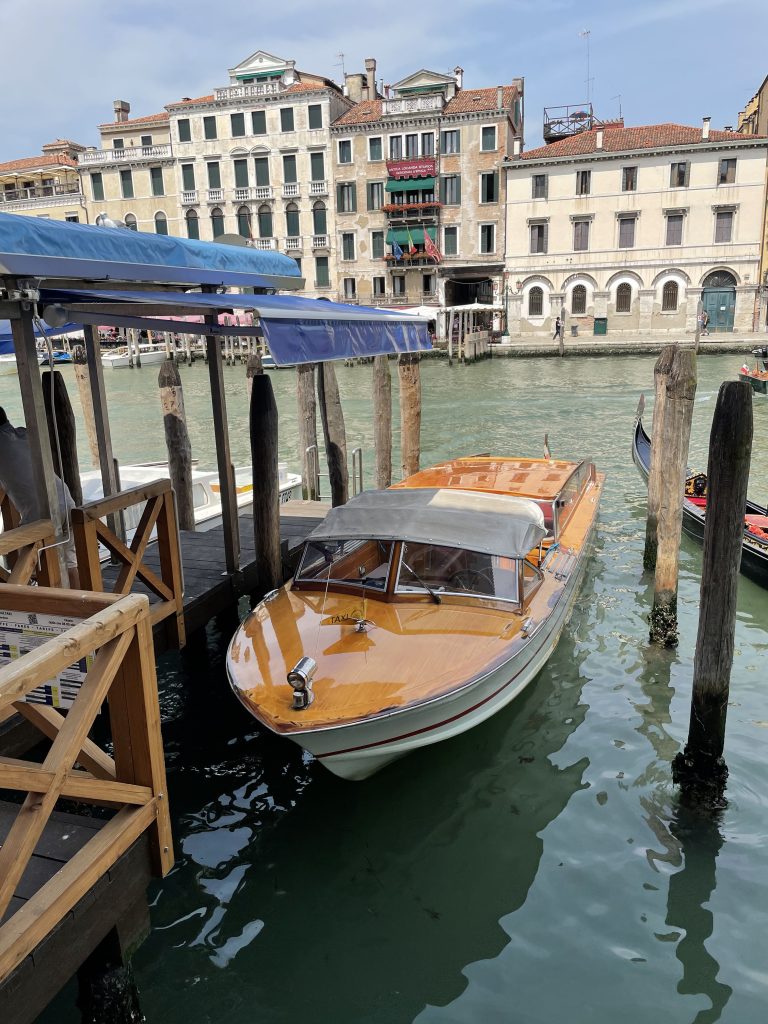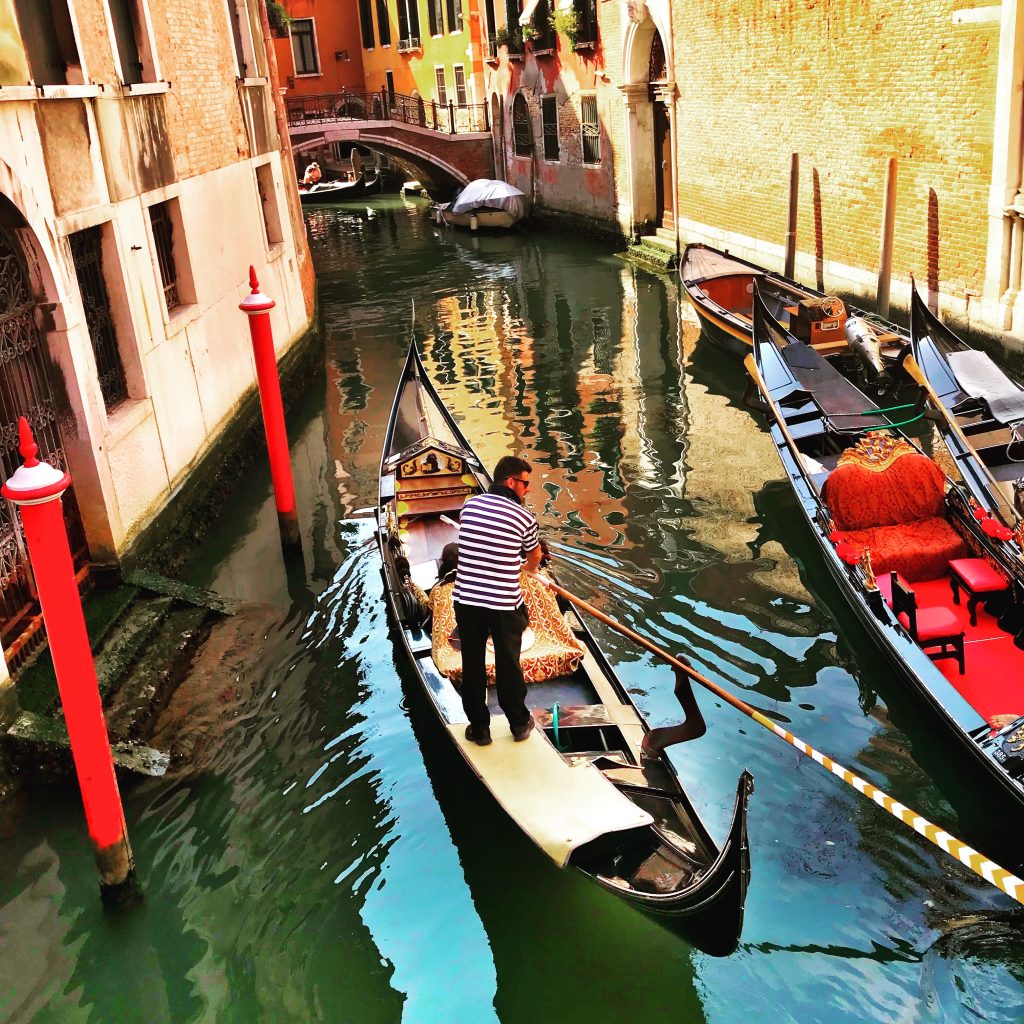What is it about Venice that makes us love her so? What makes Venice one of those cities that people love….even if they have never been there? The bridges? The glass? The canals? The gondolas? The gondoliers? The mystique?
Truth be told, I didn’t like Venice the first time I was there. The crowds. The pushing. The shoving. The crowds. The flooded piazza. The prices. The crowds.
I read once that tourists in Venice do not have a sense of staying in line. I found that to be quite true. When the gates to a vaporetto (water bus) or museum open, people start shoving. I’ve learned to get away from crowds in Venice. When I go there now, I walk the back streets and alleys, get lost, and enjoy it so much more.
Speaking of Walking…
Venice is a collection of 118 islands connected by over 400 bridges. The city also has almost 200 canals and about 125 piazzas. There are alleys that are not on the canals, but they tend to be narrow. In other words, there are no roads, so cars are banned. Visitors have to walk or take some form of water transport—water taxis, vaporetto, private boat, or gondola.
And of Gondole…
Most of my friends who have been to Venice tell me they love to take a ride on a gondola. While I’ve done it, it’s not my favorite thing to do as I prefer to have feet on the ground. What interests me more is the history behind these sleek, black boats.
Gondole (the plural of gondola) have been a means of transportation in Venice since the 11th century. At one time thousands of them crowded the Venetian canals.

The boat makers had to follow strict regulations (called mariregole) that oversaw all aspects of their lives. The mariregole legislated everything from how much the boat makers paid their apprentices, how much they paid as a dowry for their daughters, and how they buried their dead. Most importantly, it demanded that sons follow in their fathers’ footsteps.
At that time, the flat-bottomed boat had two rowers and came in a variety of colors. Well-to-do families competed with each other to see who had the fanciest, brightest color, or most gold on his gondola, so a Venetian doge ordered all gondole be painted black. Passed in the 17th century, the law has stuck for almost 500 years. (Side note: In Venice, black denotes elegance while red is the color of mourning.)
Building the Gondole
Gondole are not mass-produced. Handmade of 280 pieces of eight kinds of wood (elm, cherry, walnut, lime, mahogany, fir, oak, and larch), the gondola take about two months to build. Each one 35-feet long and weighs more than 1100 pounds. Gondole are asymmetrical and lean slightly to the right. The port side of the gondola is nine inches wider than the starboard side so that the gondolier can stand there for balance. The oarlock (forcola), the piece that holds the gondolier’s oar, has various points to support the oar and allow the gondolier to control eight different movements—starting, stopping, slowing down, turning, etc.
At the front of each gondola is a prow or fero. In Italian, fero means iron, and the fero originally served as a balance to the gondolier’s weight. Over hundreds of years, the fero has undergone many changes and modifications. Today’s fero has so much symbolism behind it.

The “s” shape of the fero symbolizes the curve of the Grand Canal. Six prongs face forward representing Venice’s six sestieri (districts). The one backward prong represents the Giudecco (the southern-most island that faces the sestieri). The curve above the prongs “is” the Rialto Bridge. Above it, the large curvy “head” of the fero represents the doge’s hat.
Some of the fero have three frieze between the prongs representing the three islands in the Venetian Lagoon—Murano, Burano, and Torcello.
The Gondolieri

In the beginning, slaves rowed the boats, but today’s gondolieri are very different. One cannot just decide to become a gondolier. Gondolieri go through rigorous training. They must begin by passing basic Voga alla Veneta rowing and swimming tests. (Voga alla Veneta is the Venetian practice of rowing while standing up.)

If they pass those two tests, they spend 12-18 months at an “arte del gondiliere” school where they take courses in a foreign language, Venetian history and culture, geography, and rowing. Prospective gondolieri have 400 hours of training before they take the exams. Once they pass all of the exams—including a very specific rowing test, they are able to register as a substitute gondolier, work the traghetti (gondole that transport people across the Grand Canal), and join the exclusive 1000-year old Gondoliers Guild.

Venice awards only 425 gondolier licenses. Each license is linked to a particular gondola station, so gondolieri always work in the same location.
The Guild also regulates the uniform of the gondolieri. They must wear dark blue or black trousers, black shoes, and a red- or blue-striped shirt. The emblem of the Gondoliers Guild is embroidered on the shirts and jackets. Straw hats with ribbons are optional.
You may also enjoy reading:
Where To Find Modern Art in Venice
MOSE Flood Barrier System in Venice













I enjoyed reading the article. It is good preparation for our trip to Venice in September. Loved the history of gondolas and learning about the preparation gondolas must pursue.
Thank you, Anne! I didn’t like Venice my first time there, but the more I go and the more I learn about her history, the more I love her now. I suggest that you read a little about the history to help you understand what the city has gone through. You will be amazed! Have a great trip.